Share this
The Top 4 Benefits For 3D Printing in Education
by 3devo on Apr 5, 2022 8:35:00 AM
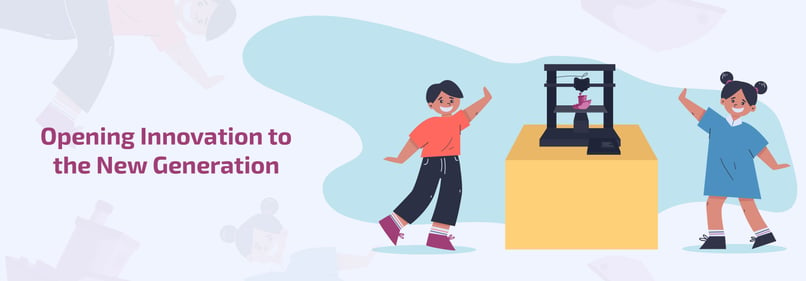
With the gradual decline in 3D printing costs, it is now becoming more viable to use 3D printing as a valuable tool in education. Once seen as a gimmick, it was only a matter of time before 3D printers made their way into a classroom or university as a valuable learning tool.
If 3D printing starts in education, simple 2D or computer-based learning can be transformed in a way that isn’t easy to achieve with current educational materials.
This article breaks down the background of 3D printing in the educational environment, the benefits of using 3D printing in learning, the subjects that benefit as well as the future of 3D printing in education.
Benefits of 3D Printing in Education
Encourages Student Participation
With the wealth of resources now available to students, creating a sustainable learning environment has become quite a challenge.
According to PewResearch, 1 in 5 YouTube users say it is very important for helping them understand things that are happening in the world. The online world is now changing the way we learn, and therefore changing the way we learn offline too.
Books, slideshows and presentations can only go so far in engaging a student’s attention. However, with 3D printing, learning becomes fun again thanks to a physical object becoming the result of their theoretical knowledge.
If you can think back to your school days, most of you would have had that one crazy science teacher, trying their best to make classes fun and enjoyable. In this process, you also tended to learn a lot too. The only issue besides many safety violations, is practical experiments were often very limited. Subjects such as geography or mathematics would turn to textbooks.
This diminishes the fun that could be available using real-life examples. 3D printing is trying to change this perception. In doing so, many benefits follow the introduction of 3D printing into Science, Technology, Engineering, Art, and Math (STEAM).
Not to mention, students who are shy or reluctant learners will be able to work and learn with their hands, not only getting them out of their seats, but helping them gain confidence and develop stronger communication skills as they learn to navigate through 3D printing.
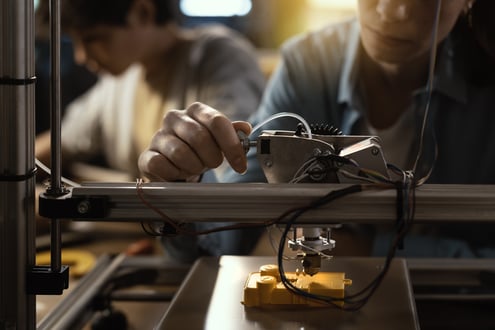
Helps Promote Creativity
As the saying goes, “give a man a fish and you feed him for a day; teach a man to fish and you feed him for a lifetime.” The same is applied in education. From the previous point, making use of a 3D printer in a classroom means that students can now be in charge to what the outcome of a problem will be.
Students will have the opportunity to create their own objects, helping to boost their creativity. For example, students from the Murtaugh School District in Idaho used 3D printer to create a solar-powered motion-sensing alarm in order to keep elk and deer out of fields.
Also with the help of products such as filament extruders, students can now test out different materials for different results. This can result in unexpected successes and failures. Both of which can help contribute to a student’s progress in learning a particular topic or subject.
Assists Visualizing Complex Subjects
Another advantage is being able to see an idea become reality.
Quite often, learning about a subject would entail many drawings in a book, maybe a video if you are lucky. But it is not always easy to understand what something looks like. For example, learning about how the Earth’s tectonic plates move around and create earthquakes.
Illustrations help, but actually creating physical objects to show students can help put it all into perspective. Using a 3D printer, explaining complex systems is easy and kids will understand how common technologies interact with each other. Our world and we interact with it isn’t all black and white. Students are realizing that they are no longer limited to visualizing complex concepts, now they can feel and touch them too.
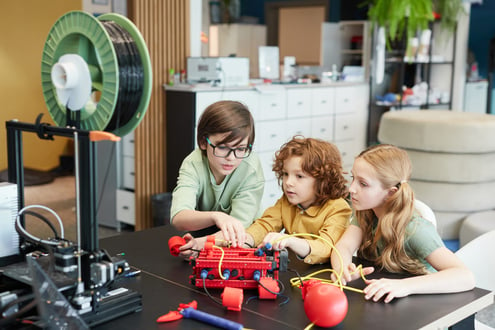
Improves Problem Solving and Analytical Thinking
The invention of 3D printing was immensely groundbreaking and provided companies and individuals with an easy way of efficiently and inexpensively manufacturing items. Including 3D printing in education offers unlimited learning opportunities for students in different fields.
There are many times during math and engineering classes where students question whether or not a certain equation will be of any use.
Well, in 3D printing, an object first needs to be designed in some type of CAD software. This often requires someone to include STEAM subjects to help understand their project. The interactive nature of 3D printing forces the student to use the knowledge they have learnt in math, engineering or other related subjects and apply them to a project and troubling shooting as they go. On the other side, students can replicate a problem or project they are busy with to help get a clearer understanding of the problem as a whole.
The options for benefits can be seen as endless, and the way you integrate them into education will reap some more than others.
Subjects That Benefit from 3D Printing
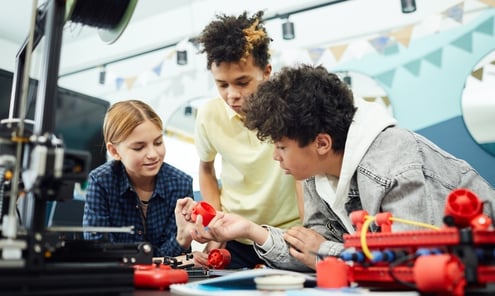
- Mathematics – Math students can print out “problems” to solve in their own learning spaces, from scale models, to city infrastructural design challenges.
- Geography – Raw data can now be turned into objects to help with: population growth, erosion effects or even how mountains are formed. Production of topography, demographic, or population maps in 3D can change the way students are learning geography.
- History – Fossils and other artifacts can now be printed. This allows students to explore and understand the past in a real and more concrete way. These replicas can be manipulated more easily than precious archaeological artifacts and produced at reasonable costs.
- Biology/Chemistry – Students can print out 3D models of molecules, cells, viruses, organs, and other critical biological artifacts. The 3D printed reproduction allows the pupils, especially the most kinesthetic of them, to understand a process or how it works.
- Recycling – Get your students up and walking around the school grounds (or their favorite park nearby) and collect plastic waste! Students will not only see the impact of littering in their neighborhood, but with a filament extrusion system alongside your 3D printer, students can actively shred the waste plastic, extrude it into filament and 3D print it into new and useful objects! Shining a new light on how to be sustainable!
University Subjects that Benefit from 3D Printing
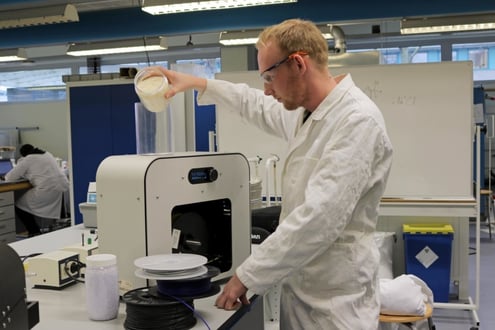
Student at Fontys University of Applied Sciences working with polymers
- Polymer Studies – Fontys University of Applied Sciences in the Netherlands uses 3D printing to enhance polymers and develop sustainable solutions for the rapidly evolving additive manufacturing industry.
- Architecture – Most of architectural sketches and mock-ups are now designed with specialized CAD-software. This allows students to materialize their ideas, saving hours not creating a study mock-up and therefore saving time to redo and improve their idea.
- Mechanical Engineering– the Mechanical Engineering Department at Embry-Riddle Aeronautical University is currently involved in ground-breaking research on battery cooling systems. Here, researchers are using the 3devo Composer Filament Maker to mix plastics and phase-change materials (PCM) into high-quality filament that can potentially 3D print lightweight, self-contained heat sinks.
- Design – Design programs are based on sketching and the producing these ideas in a design studio or lab. This is to get the whole process from a sketch to a final product. Design professors have often stated that the development of CAD programs or 3D modelling software are not always the best. This is because it will lead to students spending more time in the virtual environment than learning from the studio and practical workshops.
- Renewable Energies – Lapland University of Applied Sciences places an important role in recycling, where they get hands on with polymers to successfully improve their zero-waste footprint, and move towards a circular economy in their 3D printing lab.
The Future of 3D Printing in Education
It’s easy to see how 3D printing and filament extrusion will benefit the education sector. Students will start enjoying their subjects more often. 3D printing as a whole will become more mainstream and better adapted.
When combining these two, it will lead to a society advancing its technology and problem solving. In the next five to ten years, students will be looking back at 3D printers the way we looked at calculators at school, except with a smile knowing that they are about to turn an idea into reality.
Want to know how 3D printing is combined with research? Learn how Lapland University of Applied Sciences uses polymers to successfully improve their zero-waste footprint by clicking the button below:
Share this
- April 2024 (1)
- March 2024 (1)
- January 2024 (1)
- November 2023 (2)
- October 2023 (5)
- September 2023 (2)
- August 2023 (1)
- May 2023 (1)
- January 2023 (1)
- December 2022 (3)
- August 2022 (1)
- June 2022 (1)
- May 2022 (2)
- April 2022 (2)
- March 2022 (7)
- February 2022 (2)
- January 2022 (3)
- December 2021 (3)
- November 2021 (3)
- October 2021 (3)
- September 2021 (3)
- August 2021 (3)
- July 2021 (2)
- June 2021 (1)
- March 2021 (1)
- October 2020 (1)
- June 2020 (1)
- May 2020 (1)
- April 2020 (4)
- November 2019 (1)
- July 2019 (2)
- June 2019 (1)
- May 2019 (1)
- March 2019 (1)
- November 2018 (1)
- September 2018 (1)
- January 2018 (1)
- October 2017 (1)
- September 2017 (1)
- July 2017 (1)
- June 2017 (1)
- May 2017 (1)
- January 2017 (1)
- December 2016 (3)
- November 2016 (2)
- October 2016 (1)
- May 2016 (2)
- August 2015 (3)
- July 2015 (1)
